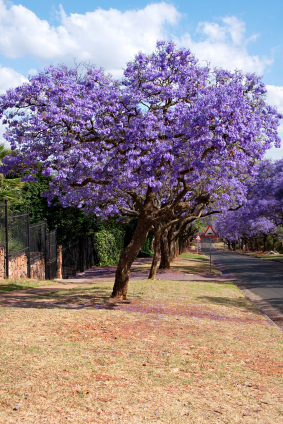Anyone who has seen the Jacaranda in full riotous bloom is unlikely to have forgotten it. Thousands of lavender, bell-like flowers create a striking contrast against the soft, feathery pale green foliage and the dark gray branches.
The Jacaranda is a big tree, reaching 40 feet in height with an equal spread, and should be planted away from overhead wires and rooflines or pruned to accommodate these impediments. Jacarandas grow well in almost any well-drained soil and may even bloom more spectacularly in poor soils. They are not salt tolerant so avoid extreme coastal locations. Trim away low-growing branches on young trees to prevent the trunk from splitting and remove any branches more than half the width of the trunk to increase stability.
The dappled shade pattern provided by the open crown of the Jacaranda makes it a good choice for sheltering porches. Falling flowers from the exuberant blooming may make this tree less desirable around swimming pools. The soft, fern-like leaves will drop in the cooler months. Some people prefer to plant the Jacaranda in a stand of evergreens to disguise its barren winter appearance. Others enjoy the sight of the stark finger-like branches against an azure Florida sky.

